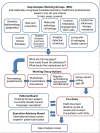Critical research gaps and translational priorities for the successful prevention and treatment of breast cancer
- PMID: 24286369
- PMCID: PMC3907091
- DOI: 10.1186/bcr3493
Critical research gaps and translational priorities for the successful prevention and treatment of breast cancer
Abstract
Introduction: Breast cancer remains a significant scientific, clinical and societal challenge. This gap analysis has reviewed and critically assessed enduring issues and new challenges emerging from recent research, and proposes strategies for translating solutions into practice.
Methods: More than 100 internationally recognised specialist breast cancer scientists, clinicians and healthcare professionals collaborated to address nine thematic areas: genetics, epigenetics and epidemiology; molecular pathology and cell biology; hormonal influences and endocrine therapy; imaging, detection and screening; current/novel therapies and biomarkers; drug resistance; metastasis, angiogenesis, circulating tumour cells, cancer 'stem' cells; risk and prevention; living with and managing breast cancer and its treatment. The groups developed summary papers through an iterative process which, following further appraisal from experts and patients, were melded into this summary account.
Results: The 10 major gaps identified were: (1) understanding the functions and contextual interactions of genetic and epigenetic changes in normal breast development and during malignant transformation; (2) how to implement sustainable lifestyle changes (diet, exercise and weight) and chemopreventive strategies; (3) the need for tailored screening approaches including clinically actionable tests; (4) enhancing knowledge of molecular drivers behind breast cancer subtypes, progression and metastasis; (5) understanding the molecular mechanisms of tumour heterogeneity, dormancy, de novo or acquired resistance and how to target key nodes in these dynamic processes; (6) developing validated markers for chemosensitivity and radiosensitivity; (7) understanding the optimal duration, sequencing and rational combinations of treatment for improved personalised therapy; (8) validating multimodality imaging biomarkers for minimally invasive diagnosis and monitoring of responses in primary and metastatic disease; (9) developing interventions and support to improve the survivorship experience; (10) a continuing need for clinical material for translational research derived from normal breast, blood, primary, relapsed, metastatic and drug-resistant cancers with expert bioinformatics support to maximise its utility. The proposed infrastructural enablers include enhanced resources to support clinically relevant in vitro and in vivo tumour models; improved access to appropriate, fully annotated clinical samples; extended biomarker discovery, validation and standardisation; and facilitated cross-discipline working.
Conclusions: With resources to conduct further high-quality targeted research focusing on the gaps identified, increased knowledge translating into improved clinical care should be achievable within five years.
Figures








Comment in
-
Help us find the cures.Breast Cancer Res. 2013;15(5):107. doi: 10.1186/bcr3566. Breast Cancer Res. 2013. PMID: 24172128 Free PMC article.
References
-
- Ferlay J, Shin HR, Bray F, Forman D, Mathers C, Parkin DM. Estimates of worldwide burden of cancer in 2008: GLOBOCAN 2008. Int J Cancer. 2010;15:2893–2917. - PubMed
-
- Breast cancer incidence statistics. http://www.cancerresearchuk.org/cancer-info/cancerstats/types/breast/inc....
-
- Leal J. Proceedings of the National Cancer Research Institute Conference: 4–7 November 2012. Liverpool; The economic burden of cancer across the European Union.
Publication types
MeSH terms
Grants and funding
- BB/C508134/1/BB_/Biotechnology and Biological Sciences Research Council/United Kingdom
- 12011/CRUK_/Cancer Research UK/United Kingdom
- 11022/CRUK_/Cancer Research UK/United Kingdom
- BREAST CANCER NOW RESEARCH CENTRE/BBC_/Breast Cancer Now/United Kingdom
- CZH/4/745/CSO_/Chief Scientist Office/United Kingdom
- NIHR-CS-011-014/DH_/Department of Health/United Kingdom
- 16463/CRUK_/Cancer Research UK/United Kingdom
- 2010NOVPR12/BBC_/Breast Cancer Now/United Kingdom
- 16464/CRUK_/Cancer Research UK/United Kingdom
- 15154/CRUK_/Cancer Research UK/United Kingdom
- 10337/CRUK_/Cancer Research UK/United Kingdom
- G0400170/MRC_/Medical Research Council/United Kingdom
- 15602/CRUK_/Cancer Research UK/United Kingdom
- MR/K011014/1/MRC_/Medical Research Council/United Kingdom
- 10118/CRUK_/Cancer Research UK/United Kingdom
- 11566/CRUK_/Cancer Research UK/United Kingdom
LinkOut - more resources
Full Text Sources
Other Literature Sources
Medical
Molecular Biology Databases
Miscellaneous

